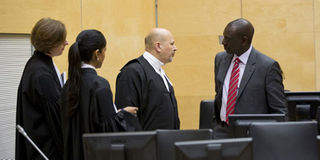Ruto accused of using violence to seize power as defence puts up spirited fight

Kenya's Deputy President William Ruto speaks with his defence team led by Karim Khan at the International Criminal Court (ICC) in The Hague September 10, 2013. ICC
What you need to know:
- Ms Bensouda and lead prosecutor in the case Anton Steynberg described Mr Ruto as a powerful politician, who assembled and coordinated a network of criminals to commit serious crimes during the post-election violence.
- Mr Sang, on the other hand, was described as the “voice of hate messages in the Rift Valley” who, through his broadcasts on Kass FM, allegedly incited the majority Kalenjin against the minority Kikuyu in the violence hotspots.
- Mr Steynberg listed the violence hotspots as Turbo, Kapsabet, Nandi Hills, Kiambaa, Langas, Kimumu, Huruma and Yamumbi areas in Nandi District and the greater Eldoret area.
International Criminal Court (ICC) Prosecutor Fatou Bensouda Tuesday said she would prove that Deputy President William Ruto and former radio presenter Joshua Sang were the main architects of the violence in Uasin Gishu and Nandi districts in early 2008.
Ms Bensouda and lead prosecutor in the case Anton Steynberg described Mr Ruto as a powerful politician, who assembled and coordinated a network of criminals to commit serious crimes during the post-election violence.
“Mr William Samoei Ruto was a powerful politician who was out to fulfil his political ambition and satisfy his thirst for political power,” Ms Bensouda told the court during her opening submissions.
She said the violence mainly targeted the Kikuyu, who, she said, were viewed by Mr Ruto’s Kalenjin as “unwelcome settlers who had misappropriated what the Kalenjin considered to be their ancestral land”.
Mr Sang, on the other hand, was described as the “voice of hate messages in the Rift Valley” who, through his broadcasts on Kass FM, allegedly incited the majority Kalenjin against the minority Kikuyu in the violence hotspots.
Ms Bensouda spoke after the charges were formally read out to Mr Ruto and Mr Sang by Presiding Judge Chile Eboe-Osuji.
Both indictees pleaded not guilty to the three charges of murder, persecution and forceful transfer of population committed during the post-election violence.
Ms Bensouda said she would rely on 22 witnesses to demonstrate how Mr Ruto assembled a network of influential Kalenjin businessmen, former military officers and youths to forcefully eject the Kikuyu from the Rift Valley.
“The Prosecution will demonstrate that Mr Ruto and his syndicate of powerful allies, including his co-accused Mr Sang, sought to exploit the historical tensions between the Kalenjin and Kikuyu for their own political and personal ends,” she said.
To achieve his objective, Mr Ruto mobilised resources and procured weapons which were used by the youths to commit the atrocities, she alleged.
She claimed it took Mr Ruto 18 months to plan the violence, during which meetings were held both at his rural Sugoi home near Turbo and across Rift Valley.
He also mobilised financial resources from Kalenjin businessmen and used his own resources to fulfil the objectives of the network, she stated.
“Using community structures, he gathered together an army of loyal Kalenjin youth to go to war for him in the event of an election loss. He also stoked the flames of anti-Kikuyu sentiment, both personally at public rallies, and indirectly through other influential speakers and through the media. And when the election was lost, he gave the order to attack. In this way, he made an essential contribution to the violence that ensued,” she said.
Ms Bensouda described Mr Sang as a radio presenter, who exploited his popularity among the Kalenjin to spread Mr Ruto’s hate messages and mobilise to go to war. “Mr Sang broadcast anti-Kikuyu rhetoric, spread the word of Mr Ruto’s rallies, and even helped to coordinate the actual attacks through coded messages. In this way, he too contributed to the violence,” she said.
She continued: “Mr Ruto’s ultimate goal was to seize political power for himself and his party ODM through violent means if he could not do so through the ballot.”
Mr Steynberg listed the violence hotspots as Turbo, Kapsabet, Nandi Hills, Kiambaa, Langas, Kimumu, Huruma and Yamumbi areas in Nandi District and the greater Eldoret area. He said the prosecution would prove that the attacks in these areas were not spontaneous but were as a result of careful planning.
The prosecution witnesses, Mr Steynberg said, would demonstrate that the attacks were preceded by the traditional Kalenjin war cry and that the attacks mainly targeted areas predominantly inhabited by the Kikuyu community who Mr Ruto and other members of his network allegedly referred to as “madoadoa”.
The attackers also wore uniforms, he said.
“The witnesses will testify that members of the network provided transport, weapons and refreshments to the attackers,” Mr Steynberg said.
Mr Ruto will return home tomorrow evening after his trial was adjourned because the first prosection witness had not arrived. Mr Ruto will return to The Hague on Tuesday when the prosecution says it will have its first witness ready.





